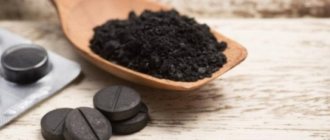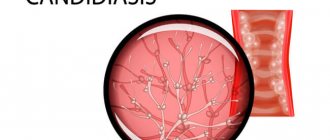Thrush, or candidal infection, accompanied by damage to the vaginal mucosa, is a problem for many women. The symptoms of this disease are so unpleasant that they completely knock the patient out of rhythm: due to severe itching, she cannot work normally, be sexually active, or even sleep peacefully.
THE COST OF AN APPOINTMENT WITH A GYNECOLOGIST IN OUR CLINIC IS 1000 rubles.
CLICK TO MAKE AN APPOINTMENT, TEST OR ULTRASOUND
Unfortunately, medications for thrush are advertised everywhere, which is why, having contracted candidiasis, women run not to the doctor, but to the pharmacy. After some time, the disease returns, which is natural, because such an infection cannot be cured with one pill; complex therapy is needed. That is why, at the first signs of thrush, you need to make an appointment with a good gynecologist and undergo full treatment. Today we will dispel myths about the treatment of thrush and formulate a number of recommendations that every woman should know.
Is thrush really a problem?
The content of the article
People of all ages suffer from candidiasis, with the peak incidence occurring between 20 and 40 years of age. According to statistics, 60% of women have been diagnosed with thrush at least once in their lives, and in 9%, candidiasis has a recurrent (repeating) course. In reality, this figure is higher, since in many patients the disease does not produce noticeable symptoms and the fungus is detected only when swabs are taken from the vagina.
The main problems of this pathology are self-medication, which leads to the disease becoming chronic, and negligent attitude towards one’s health. Gynecologists at the Diana Medical Center daily encounter cases of thrush, the severity of which is due to the patients’ late seeking of professional medical help.
Why thrush develops: causes of candidiasis
The main cause of the disease is fungi of the genus Candida. Normally, the fungus lives in the body of any person, but under certain circumstances, as a result of the influence of various predisposing factors, it begins to actively multiply. Therefore, such microorganisms are called opportunistic.
Normal vaginal microflora keeps the fungus from excessively multiplying. When it changes (dysbiosis), the growth of Candida increases, and thrush .
Stimulate the activation of infection:
- hormonal changes in the body: pregnancy, menopause, diseases of the endocrine system (diabetes, thyroid problems), incorrect selection of birth control pills;
- violation of personal hygiene rules and wearing synthetic underwear - the fungus loves dampness, warmth and does not like fresh air;
- douching, using aggressive cleaning agents;
- the presence of sexually transmitted infections, inflammation of the internal female organs, infection with thrush from a partner;
- diseases accompanied by changes in the concentration of sex hormones in the blood,
- pregnancy and chronic foci of infection in the body, weakening the immune system;
- uncontrolled use of antibiotics, which destroy, along with parasitic flora, beneficial lactobacilli - protectors of the mucous membrane.
It’s easy to provoke candidiasis: just walk around in tight synthetic panties in the heat. The fungus develops instantly in such conditions - it loves moisture, warmth, and does not need air.
Etiology of VK
Candida spp., the causative agents of vaginal candidiasis, are opportunistic fungi that are the most common cause of fungal infections in humans. The genus Candida has about twenty species. As a rule, BK is associated with one species of Candida, but there is a probability (2-5%) of simultaneous infection with two or more species.
In Russia, the USA, Australia and Europe, Candida albicans is most often detected in women with VK (76-89%). It is followed by C. glabrata (7-16%). The percentage of non-albicans Candida ranges from 11 to 24%. Some studies have shown a trend toward an increase in the incidence of non-albicans candidiasis, but recent work by scientists in the United States involving ninety thousand samples refuted this assertion: the proportion of Candida species causing BK remained virtually unchanged from 2003 to 2007.
Etiologically, various candidiasis are clinically very similar, however, atypical pathogens are characterized by resistance to azole antimycotics. C. glabrata and C. krusei are more resistant to azole antifungal drugs than others.
CC dossier
Marina Pozdeeva
pharmacist of the first category and head of the pharmacy. Author of numerous works on pharmacology and pharmacotherapy, Dnepropetrovsk.
These data highlight the importance of identifying Candida spp. in women with a high risk of developing non-Candida albicans-associated VK in order to select effective therapy for the disease.
Is thrush contagious?
Keep in mind that candidiasis is a contagious disease and is easily transmitted to a sexual partner, so you will have to be treated together. The disease is often confused with an STD. In fact, thrush does not belong to this group, but contact with a man suffering from candidiasis will provoke the development of infection. A woman also transmits Candida to her partner. In men, thrush occurs more easily, this is due to good access of air to the mucous membrane of the head, but even without obvious signs, a once infected man becomes a carrier of the infection.
Treatment of RVC caused by non-albicans Candida species
Non-albicans species respond very moderately to therapy with azole antimycotics. Therefore, the treatment regimen in such cases is selected individually, based on the severity of the disease and response to drugs.
Topical boric acid has been used to treat RVC for many decades. However, boric acid preparations can be absorbed through the vaginal mucosa into the blood and have a toxic effect. To avoid absorption, boric acid-based vaginal products are released in gelatin capsules. The recommended treatment regimen is one 600 mg capsule per day for two weeks.
There is no ready-made dosage form in Russia, but capsules can be prepared in pharmacies ex tempore. Studies have shown that treatment with vaginal boric acid capsules is effective in 70% of cases of C. glabrata-associated RVC.
An alternative to toxic boric acid is suppositories with amphotericin B. The antibiotic penetrates the cell membrane of the fungus and, by binding to ergosterol, destroys the cell wall. The course of treatment is 50 mg at night per os for two weeks. This treatment regimen is successful in 70% of patients suffering from disease caused by non-albicans species that are not amenable to azole therapy, especially C. glabrata.
Local preparations for vaginal use containing 17% flucytosine have also proven activity against non-albicans Candida species. Fungal cells absorb flucytosine, after which it is deaminated and converted into 5‑fluorouracil, which is incorporated into Candida DNA instead of uracil. As a result, protein synthesis is disrupted and the cell dies. A combination of 17% flucytosine cream and 3% amphotericin B cream is also possible. The average duration of treatment with flucytosine should be at least two weeks. The peculiarity of the drug is its high cost.
Symptoms of thrush: what a woman feels with candidiasis
Candidiasis is difficult to miss - it is one of the most unpleasant diseases. A woman is worried about incessant itching in the genital area, frequent painful urination (dysuria), pain and discomfort during sexual intercourse (dyspareunia), associated with vaginal dryness and injury. The main sign of fungal activity is a cheesy discharge. Whitish deposits begin to form on the reddened mucosa, which separate and form a cheesy vaginal discharge. In men, thrush manifests itself as redness of the head, a white coating accumulates on it, and red spots may form.
In advanced stages, the infection from the external genitalia spreads to the anal area. Cracks in the mucous membrane occur, accompanied by pain during defecation. If thrush is not treated, it becomes chronic and torments the woman constantly - during hypothermia, menstruation, after bathing, when personal hygiene rules are violated or in the premenstrual period, when hormonal levels change, etc.
Against the background of thrush, due to scratching and weakening of the natural flora of the vagina, a bacterial infection can develop, leading to bacterial vaginitis. Vaginitis quickly spreads to the uterus and its appendages, which in some cases can lead to decreased fertility (the ability to conceive), even to infertility.
If any symptoms of thrush appear, especially during pregnancy or breastfeeding, you should contact your doctor to confirm the diagnosis and prescribe timely treatment. The doctor makes a final diagnosis after receiving the test result (smear). A small amount of fungus does not cause disease and is normal.
Risk factors
In many healthy women, VC develops sporadically. However, there are risk factors for candidiasis. Behavioral factors include frequent sexual intercourse and oral sex, as well as the use of spermicides.
Tight clothing and underwear usually do not cause illness. However, among women with recurrent VC (RVC), wearing tight tights and panty liners is positively associated with recurrence.
Biological risk factors for VC include:
- use of antibiotics;
- uncontrolled diabetes mellitus;
- genetic predisposition;
- high levels of sex hormones;
- taking oral contraceptives containing high doses of estrogen;
- pregnancy.
Antibacterial drugs help reduce the number of lacto- and bifidobacteria, a shift in pH in the vagina and the growth of Candida spp.
Tetracyclines, cephalosporins and ampicillin are more likely than other broad-spectrum antibiotics to provoke the development of candidiasis.
Pregnancy is one of the most common predisposing factors. According to studies, a third of pregnant women develop VK. High levels of sex hormones increase the glycogen content in the vagina, which in turn provides a constant source of carbon necessary for the growth of fungi.
Additionally, the increased acidity of the vaginal flora during pregnancy may inhibit the growth of other microorganisms that naturally inhibit Candida. Although the initial attachment of fungal cells occurs at higher pH values (6–7), an acidic environment favors mycelial development.
In the pathogenesis of vaginal candidiasis (VC), two main phases are distinguished: the adhesion phase, that is, the attachment of fungal cells to epithelial cells, and the mycelial phase. The mycelial phase begins with the entry of Candida spp. into epithelial cells. The growing pseudomycelium of fungi penetrates into the deep layers of the cervical and vaginal epithelium.
Candida are able to penetrate cells without violating the integrity of their mannoprotein membrane (this is the fibrillar coating of the cell wall of the fungus involved in adhesion processes). As a result, Candida resists defense factors and survives in the macroorganism.
Groups at risk for infection with non-albicans Candida species include:
- women with recurrent VK;
- HIV-infected women;
- women over 50 years of age;
- women with uncontrolled diabetes.
In all of the above groups, the most common species is C. glabrata.
The percentage of cases of non-albicans Candida-associated infection increases with women's age.
Features of RVC
Most women with VK respond quickly to therapy, but some may develop a relapsing form, characterized by four or more episodes of infection per year. Predisposing factors:
- uncontrolled diabetes mellitus;
- taking immunosuppressants;
- deviations in the local vaginal immunity of the mucous membranes;
- genetic predisposition.
Studies have proven that patients with RVC have a higher frequency of specific gene polymorphisms compared to the control group. In addition, these patients have certain Lewis system antigens in their blood.
Intermittent VK may also be associated with decreased in vivo concentrations of mannose-binding lectin. The latter, by binding to sugars on the surface of the Candida cell, triggers the pathway of activation of the complement system and leads to the death of the fungus through complement-mediated phagocytosis.
With this disease, an increased concentration of interleukin-4 is also recorded, which inhibits local protective mechanisms.
The Lewis antigen system depends on a group of genes that are expressed in the glandular epithelium. Lewis antigens, unlike erythrocyte antigens, are components of exocrine epithelial secretions, including vaginal ones.
The role of sexual transmission remains unproven. However, most studies indicate the need for treatment of sexual partners. Thus, an experiment by Dr. Horowitz, UK, demonstrated the presence of Candida species in the ejaculate of men whose partners suffered from RVC.
However, the same Horowitz conducted another study, which studied the results of therapy in 54 women, divided into two groups. Partners from the first group were subjected to antifungal therapy, but those from the second were not. There were no significant differences in the rate of relapse among women in these groups.
Relapses can also be caused by other Candida species that are not equally sensitive to first-line therapy.
Diagnosis of thrush
Making a correct diagnosis is not a problem for an experienced doctor, but you will still have to take a smear to determine the purity of the flora. After all, thrush is rarely the only problem; as a rule, the analysis reveals a whole bunch of concomitant infections. Sexually transmitted infections are the cause of recurrent thrush in most cases.
To determine the best antifungal agent, the isolated fungi are inoculated and drugs are tested on them, determining the most effective one.
Herbs
Many types of herbs are used as a remedy to treat thrush at home. Some of them have properties that prevent the proliferation of fungus, enhance tissue regeneration and restore the vaginal microflora. The most popular herbs in this category are calendula, chamomile, St. John's wort, yarrow, sage and string.
It is not recommended to use herbal infusions for prevention - abuse of such drugs can lead to vaginal dryness.
Herbs are usually used in the form of infusions or decoctions. To prepare the infusion, pour a tablespoon of raw material into a glass of boiling water and leave for about half an hour. The decoction is prepared from ingredients with the same proportions, boiled over low heat for 3-5 minutes, then left to cool. Before use, the finished liquid must be filtered thoroughly.
Herbs for thrush are used as douches, washes and for preparing baths. They can be combined, using in equal proportions, or you can prepare an infusion from only one type of plant.
Note. Their effect on the body is individual, so the best option can only be determined experimentally. However, the most effective herbs are chamomile and calendula - with their help you can cure thrush at home quite quickly.
Treatment of thrush: only complex therapy
Contrary to popular belief, thrush is not cured with one pill. A doctor’s professional approach involves a set of measures.
The doctor selects antifungal drugs that can be taken:
- orally to reduce the amount of fungus throughout the body;
- in the form of suppositories or ointments locally - they quickly relieve the symptoms of candidiasis.
Treatment of thrush must necessarily include normalization of personal hygiene and treatment of STIs, if detected.
To combat Candida fungi, antifungal drugs are used, most often in the form of suppositories or a special vaginal gel. It is also necessary to take antifungal drugs internally. At the same time, the doctor will prescribe restorative therapy that restores immunity and normal vaginal flora. The patient is prescribed vitamins and immunostimulants that improve immunity. After completion of antibacterial therapy, the flora is restored with medications containing lactobacilli - this is the most important part of the beneficial microflora of the vagina.
Men will also have to take pills and treat the penis daily with a special solution or ointment prescribed by the doctor.
Prevention consists of rational use of antibiotics, regular visits to the gynecologist with taking smears for flora, strengthening the body, maintaining hygiene and refusing to wear synthetic underwear in hot weather.
Bibliography
- Gynecology textbook. IV edition ed. Academician of the Russian Academy of Medical Sciences, Professor G.M. Savelyeva; prof. V.G. Breusenko 2012
- Urogenital candidiasis. Clinical recommendations. Moscow, 2016 – 22 p.
- Vulvovaginal candidiasis: pathogenesis, diagnosis and treatment tactics. Bayramova G.R., Amirkhanyan A.S., Chernova V.F. //Doctor.Ru 2018. No. 10 (154). pp. 32-36
- Sherry L., Kean R., McKloud E., O'Donnell LE, Metcalfe R., Jones BL et al. Biofilms formed by isolates from recurrent vulvovaginal candidiasis patients are heterogeneous and insensitive to fluconazole. Antimicrob. Agents. Chemother. 2017; 61(9): e01065-17
- Prilepskaya V.N. Vulvovaginal candidiasis. Clinic, diagnosis, principles of therapy: manual / V.N. Prilepskaya, G.R. Bayramova - M 2008 - 50s
- Atlas of pathogens of fungal infections/E.N. Moskvitina and others - Moscow GEOTAR-Media, 2021 208p
- Zordan R., Cormack B. Adgesis on opportunistic fungal pathogens In: Calderone RA, Clancy CJ, ed Candada and candidiasis/ Washington: ASM press; 2012: 243-259)
- Zhang Y., Li W., Chu M., Chen H., Yu H., Fang C. et al. The AAA AT Pase Vps4 plays important roles in Candida albicans hyphal formation and is inhibited by DBeQ. Mycopathology 2016; (5-6) 329-39
- Murciano C., Moyes DL, Runglall M., Yobouti P., Islam A., Hoyer LL et al. Evaluation of the role of Candida albicans agglutinin-like sequence (Als) proteins in human oral epithelial cell interactions. Plos one 2012.
- Center for Disease Control (CDC) Sexually Transmitted Disease Treatment Guidelines, 2015.
- Donders GG, Bellen G., Mendling W. Management of recurrent vulvovaginal candidosis as a chronic illness. Gynecol. Obstet. Invest 2010 70(4):306-21
- Ankirskaya A.S. Muravyova V.V. Microbiological characteristics of vaginal infections caused by fungi of the genus Candida // sexually transmitted diseases 2001. pp. 12-14
- Eschenbach DA Chronic vulvovaginal candidosis N Engl. J Med 2004; 351(9)
- Tikhomirov A.L. Oleinik Ch.G. Optimization of treatment of recurrent vulvovaginal candidiasis // effective therapy in obstetrics and gynecology. 2007 No. 3 from 22-27
- Bayramova G.R. Recurrent vaginal candidiasis. Clinic, diagnosis, treatment. dis. Doctor of Medical Sciences M. 2013 (46s)
- Prilepskaya V.N. Bayramova G.R. Vulvovaginal candidiasis, modern ways to solve the problem. Difficult patient 2006 (from 33-36)
Myths and truth about treating thrush
Myth No. 1. Thrush is normal!
The causative agent of thrush is fungi of the genus Candida, which are classified as opportunistic microorganisms. This means that they are contained in small quantities in the microflora of the body of healthy women. This fact leads some patients to believe that periodic manifestations of thrush do not deserve attention.
This is a misconception, because normally fungal pathogens do not cause unpleasant symptoms and do not bring discomfort to their owner. But in large quantities, Candida becomes dangerous, so thrush needs to be treated.
Myth No. 2. If thrush is not treated, it will go away on its own
This misconception, propagated on many websites, has led to the spread of chronic thrush among young women.
The primary symptoms of the disease - severe itching and curdled discharge, characteristic of the acute phase of the disease, indeed, even without treatment, gradually fade away. But this is a false sense of recovery. After some time, the troubles will return again - at the moment when the body experiences severe physical or psychological stress. In addition, the recurrence of thrush is facilitated by changes in hormonal levels, which occurs during menstruation and during pregnancy.
Myth No. 3. One tablet is enough to treat thrush!
The advertisement claims that after taking one capsule of the miracle drug, a woman will forever forget about the symptoms of thrush. Yes, the thrush may go away, but it will be replaced by severe dysbiosis, vaginosis and other diseases associated with disturbances in the vaginal microflora.
All antifungal agents used in the treatment of candidiasis (thrush) are drugs that specifically suppress pathological flora. At the same time, a safe drug should have a gentle effect on the mucous membrane without causing dysbacteriosis. In other words, he should treat smoothly, leaving time for the body to adapt. Whereas the “killer dose” will destroy both the causative agent of thrush and all living things, freeing up a springboard for colonization by new fungi and bacteria.
In addition, thrush rarely comes alone. Analysis (smear) sometimes reveals a whole bunch of STDs. In this case, combination treatment is required.
Myth No. 4. Local remedies for thrush are useless
Topical antifungal drugs quickly suppress fungal growth and play an important role in the treatment of thrush. Candles, creams, gels and sprays do not cause side effects and have no restrictions on use. But local therapy is considered by gynecologists exclusively as an additional measure, since it is effective only in the early stages of the development of pathology.
At the same time, suppositories and ointments are the drugs of choice in the treatment of candidiasis in pregnant and lactating women.
Myth No. 5. The appearance of thrush does not depend on lifestyle
The development of thrush always has a specific cause. Frequent stress, poor diet and heavy physical activity, which weaken the immune system, activate the fungal flora. Failure to comply with personal hygiene rules also affects the state of the vaginal microflora; in addition, the disease can be acquired by changing partners and using traumatic sex toys.
Another, perhaps significant reason is the uncontrolled use of antibiotics that affect the flora of the body. Broad-spectrum antibacterial drugs are not able to distinguish “bad” bacteria from “good” ones; they kill everything not only in the vagina, but also in the stomach and intestines. Therefore, lovers of self-medication are in for a surprise in the form of dysbiosis and accompanying candidiasis.
Myth No. 6. The most effective treatment for thrush is traditional medicine!
Traditional methods of treating candidiasis usually come down to the use of infusions and decoctions of herbs for washing and douching the vagina. For this purpose, herbs with antibacterial and antifungal effects are used.
These measures are good only as an aid to the main treatment, but thrush cannot be cured in this way. For quality treatment of vaginal candidiasis, you need to take antifungal drugs, immunostimulants and vitamins. Only this set of medications is guaranteed to reduce the likelihood of relapse of the disease.
Proper diet
To cure candidiasis in women and remove its consequences, it is advisable to combine medication with diet. The main goal is to deprive the Candida fungus of the nutrition it needs. Since this microorganism loves sugar and carbohydrates, first of all you should give up:
- sweet fruit juices;
- honey and other sweets;
- Sahara;
- corn, beets, potatoes, pumpkin, watermelon and other sweet fruits;
- alcohol.
But it’s worth adding more meat, unsweetened vegetables, nuts, eggs, fish, kefir, fermented baked milk and natural yoghurt to the menu.
By the way, this diet is useful for the prevention of candidiasis in women, so you can diversify your diet from time to time, even if you do not have thrush.








